Abstract
The prolonged ventricular dysfunction following brief periods of coronary artery occlusion that does not produce irreversible damage has been termed the "stunned" myocardium. Although ventricular function returns to preischemic values by 1 to 7 days after reperfusion is established, inotropic therapy may be necessary to enhance contractility in the stunned heart. The purpose of this study was to determine the effect of pyruvate on ventricular function in normal and stunned myocardium. Eight chloralose/urethane anesthetized dogs were instrumented with ultrasonic crystals to measure systolic wall thickening in the left anterior descending artery (LAD) and left circumflex artery perfused regions of the left ventricle. Pyruvate (1 ml/min of 150 mM sodium pyruvate, pH 7.4) was infused directly into the LAD prior to and 30 minutes after a 10 minute LAD occlusion. Prior to LAD occlusion, LAD pyruvate infusion increased systolic wall thickening in the LAD-perfused region from 16.2% +/- 4.3% to 23.4% +/- 5.1% (p less than 0.05). Thirty minutes after LAD occlusion, regional wall thickening was depressed (3.3% +/- 2.6%; p less than 0.05), which is indicative of stunned myocardium. Subsequent LAD pyruvate infusion increased wall thickening in the stunned myocardium to 12.7% +/- 2.5%. The improvement of regional ventricular function was maintained only during the pyruvate infusion, as function returned to prepyruvate levels within 20 minutes after cessation of pyruvate infusion. These data indicate that pyruvate exerts a positive inotropic effect in normal and stunned myocardium. If pyruvate, a key intermediate in energy-producing pathways, exerts its inotropic effect through an enhancement of the energy state of the heart, it may have advantages over traditional inotropic agents in the treatment of postischemic contractile dysfunction.
Full text
PDF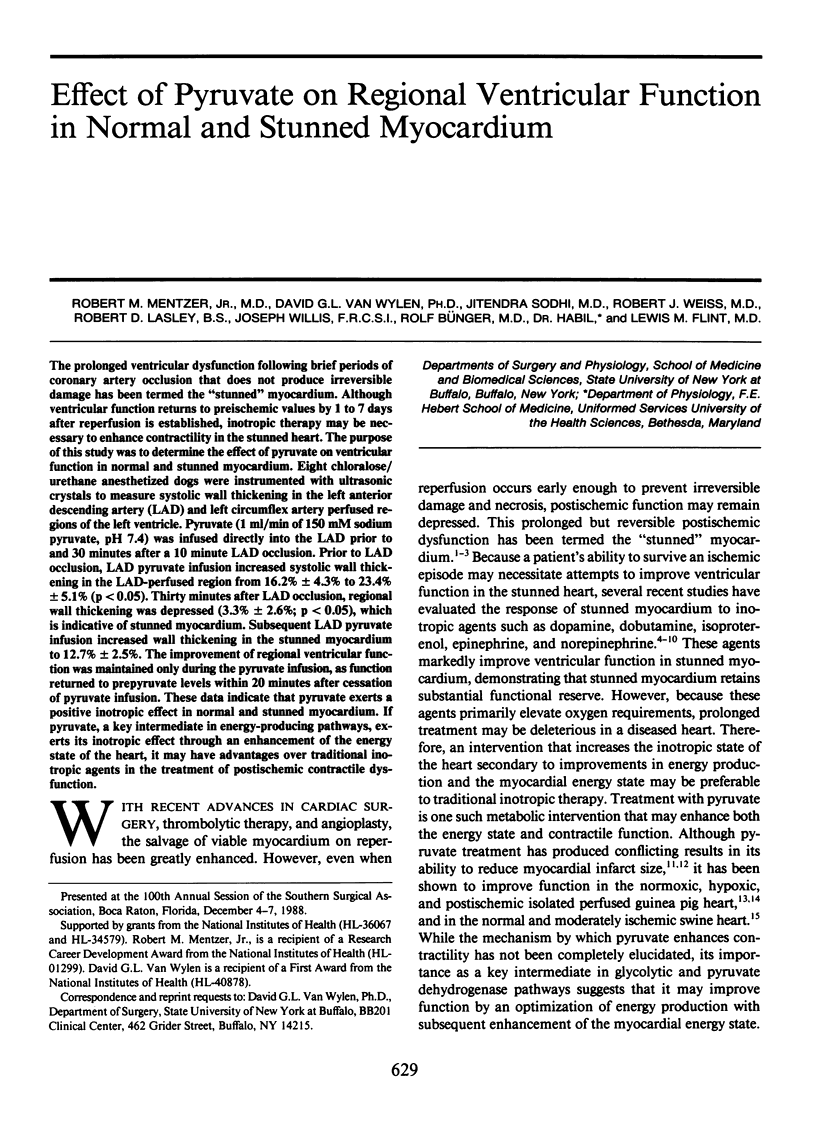
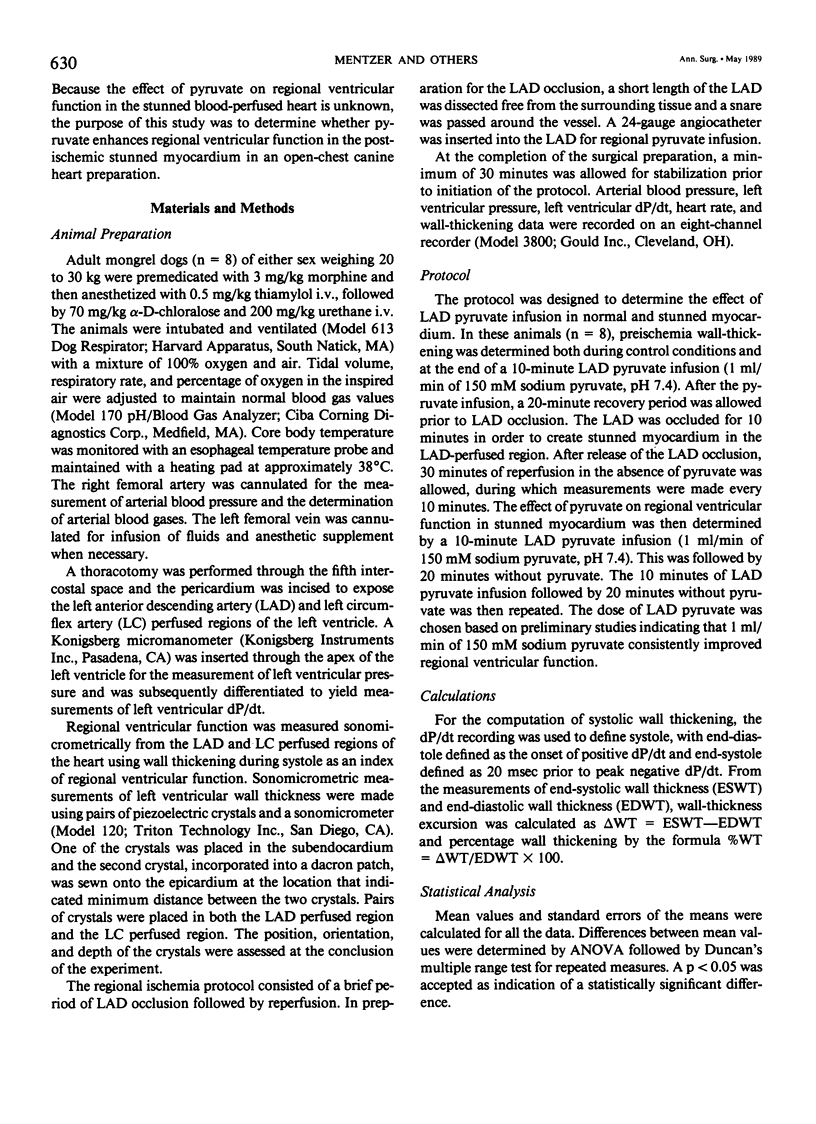
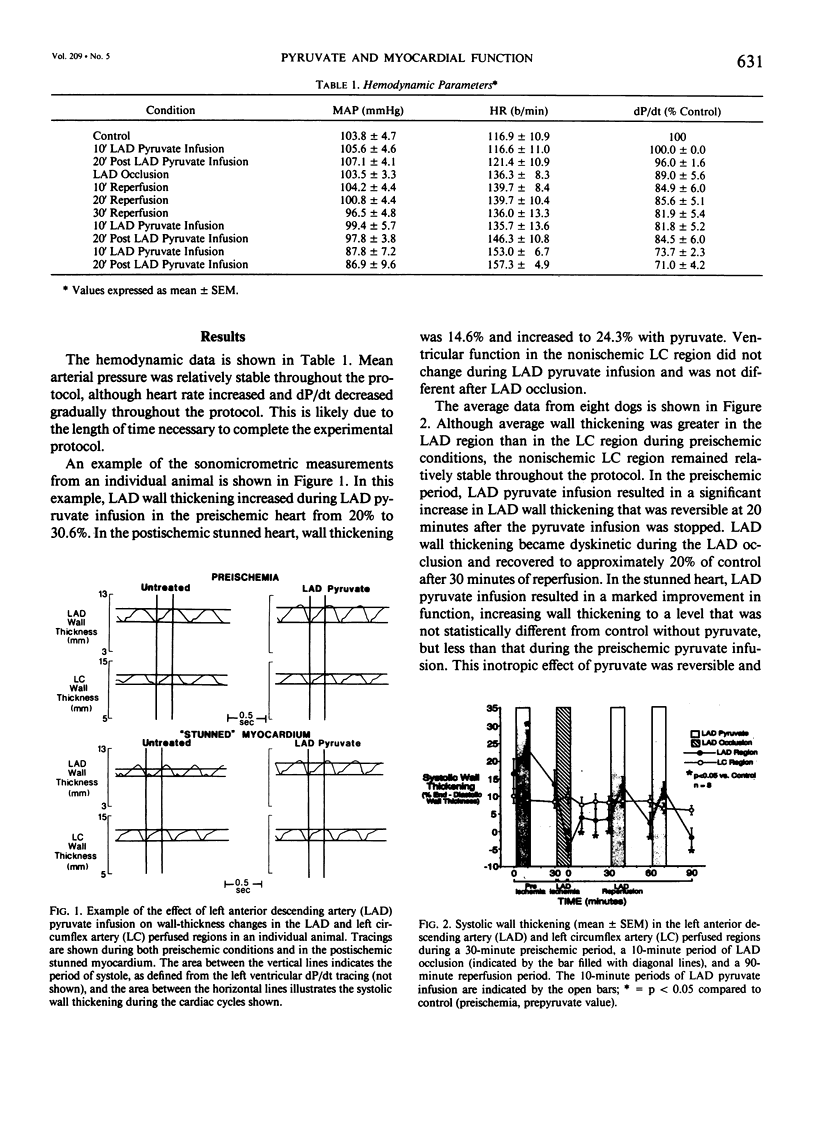
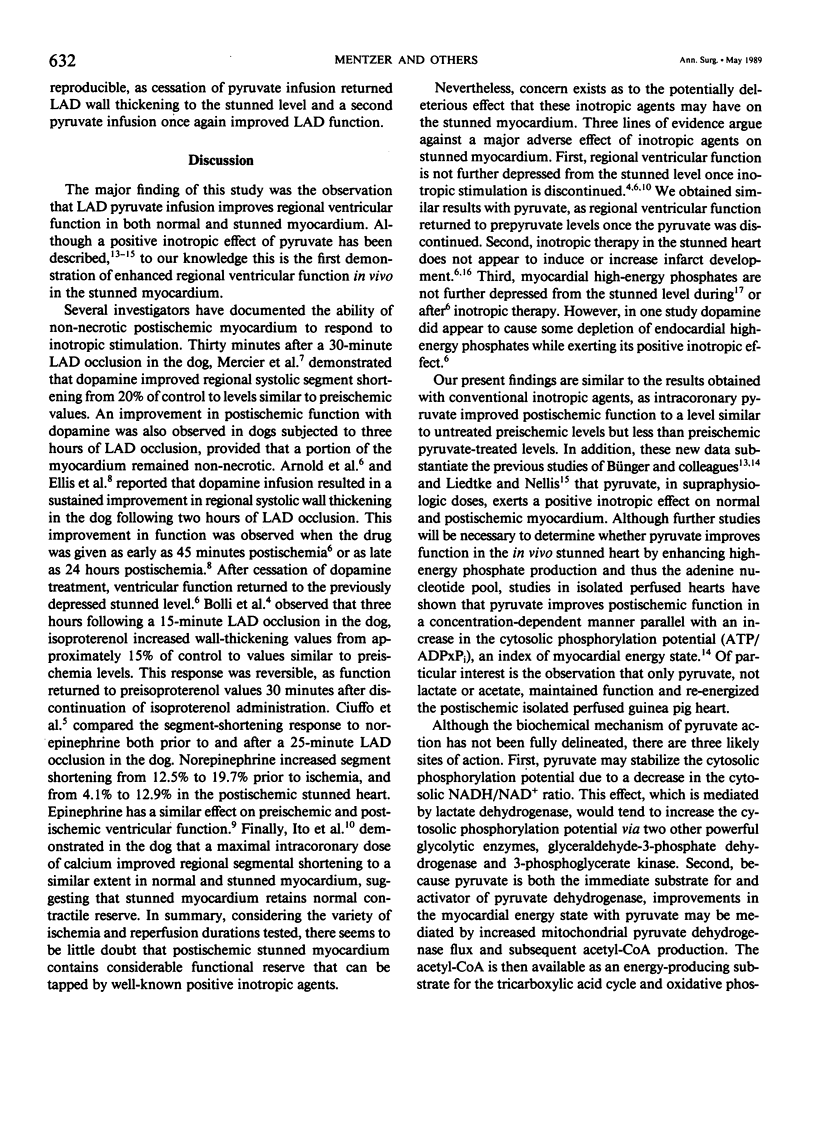
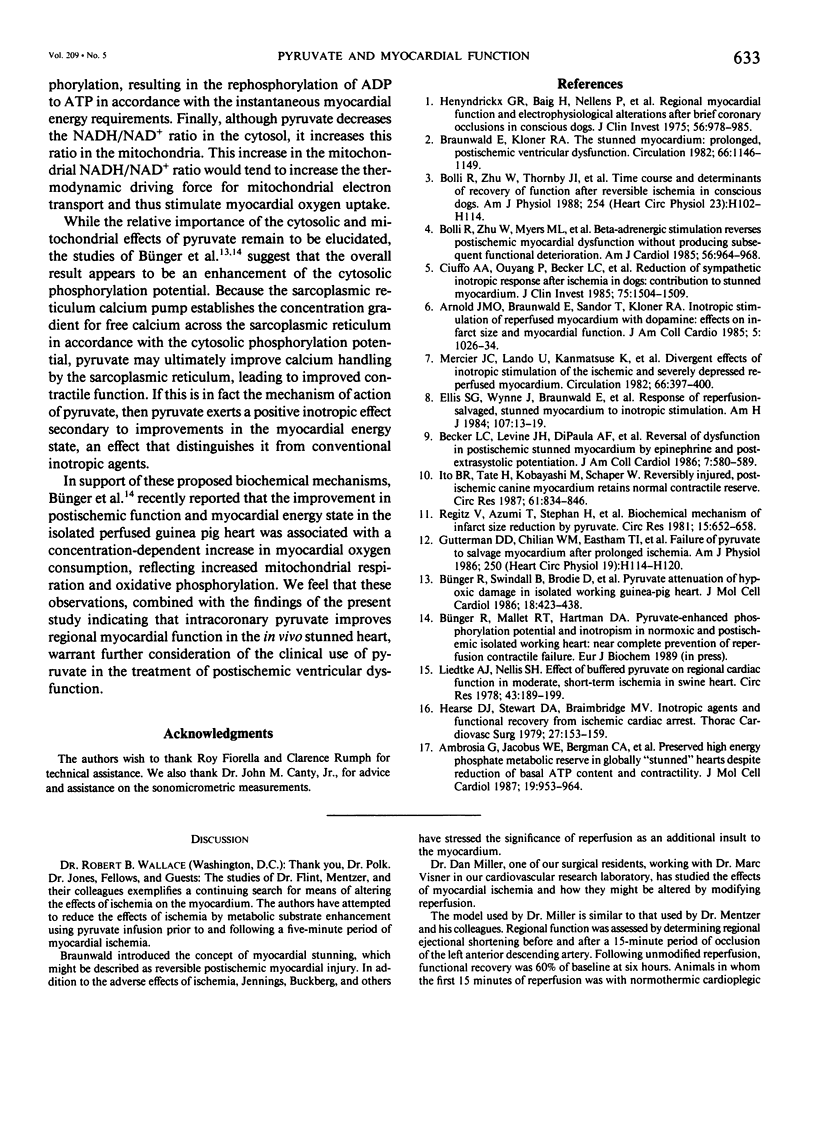
Images in this article
Selected References
These references are in PubMed. This may not be the complete list of references from this article.
- Ambrosio G., Jacobus W. E., Bergman C. A., Weisman H. F., Becker L. C. Preserved high energy phosphate metabolic reserve in globally "stunned" hearts despite reduction of basal ATP content and contractility. J Mol Cell Cardiol. 1987 Oct;19(10):953–964. doi: 10.1016/s0022-2828(87)80568-0. [DOI] [PubMed] [Google Scholar]
- Arnold J. M., Braunwald E., Sandor T., Kloner R. A. Inotropic stimulation of reperfused myocardium with dopamine: effects on infarct size and myocardial function. J Am Coll Cardiol. 1985 Nov;6(5):1026–1034. doi: 10.1016/s0735-1097(85)80305-3. [DOI] [PubMed] [Google Scholar]
- Becker L. C., Levine J. H., DiPaula A. F., Guarnieri T., Aversano T. Reversal of dysfunction in postischemic stunned myocardium by epinephrine and postextrasystolic potentiation. J Am Coll Cardiol. 1986 Mar;7(3):580–589. doi: 10.1016/s0735-1097(86)80468-5. [DOI] [PubMed] [Google Scholar]
- Bolli R., Zhu W. X., Myers M. L., Hartley C. J., Roberts R. Beta-adrenergic stimulation reverses postischemic myocardial dysfunction without producing subsequent functional deterioration. Am J Cardiol. 1985 Dec 1;56(15):964–968. doi: 10.1016/0002-9149(85)90413-8. [DOI] [PubMed] [Google Scholar]
- Bolli R., Zhu W. X., Thornby J. I., O'Neill P. G., Roberts R. Time course and determinants of recovery of function after reversible ischemia in conscious dogs. Am J Physiol. 1988 Jan;254(1 Pt 2):H102–H114. doi: 10.1152/ajpheart.1988.254.1.H102. [DOI] [PubMed] [Google Scholar]
- Braunwald E., Kloner R. A. The stunned myocardium: prolonged, postischemic ventricular dysfunction. Circulation. 1982 Dec;66(6):1146–1149. doi: 10.1161/01.cir.66.6.1146. [DOI] [PubMed] [Google Scholar]
- Bünger R., Swindall B., Brodie D., Zdunek D., Stiegler H., Walter G. Pyruvate attenuation of hypoxia damage in isolated working guinea-pig heart. J Mol Cell Cardiol. 1986 Apr;18(4):423–438. doi: 10.1016/s0022-2828(86)80905-1. [DOI] [PubMed] [Google Scholar]
- Ciuffo A. A., Ouyang P., Becker L. C., Levin L., Weisfeldt M. L. Reduction of sympathetic inotropic response after ischemia in dogs. Contributor to stunned myocardium. J Clin Invest. 1985 May;75(5):1504–1509. doi: 10.1172/JCI111854. [DOI] [PMC free article] [PubMed] [Google Scholar]
- Ellis S. G., Wynne J., Braunwald E., Henschke C. I., Sandor T., Kloner R. A. Response of reperfusion-salvaged, stunned myocardium to inotropic stimulation. Am Heart J. 1984 Jan;107(1):13–19. doi: 10.1016/0002-8703(84)90126-1. [DOI] [PubMed] [Google Scholar]
- Hearse D. J., Stewart D. A., Braimbridge M. V. Inotropic agents and functional recovery from ischemic cardiac arrest. Thorac Cardiovasc Surg. 1979 Jun;27(3):153–159. doi: 10.1055/s-0028-1096236. [DOI] [PubMed] [Google Scholar]
- Heyndrickx G. R., Millard R. W., McRitchie R. J., Maroko P. R., Vatner S. F. Regional myocardial functional and electrophysiological alterations after brief coronary artery occlusion in conscious dogs. J Clin Invest. 1975 Oct;56(4):978–985. doi: 10.1172/JCI108178. [DOI] [PMC free article] [PubMed] [Google Scholar]
- Ito B. R., Tate H., Kobayashi M., Schaper W. Reversibly injured, postischemic canine myocardium retains normal contractile reserve. Circ Res. 1987 Dec;61(6):834–846. doi: 10.1161/01.res.61.6.834. [DOI] [PubMed] [Google Scholar]
- Liedtke A. J., Nellis S. H. Effects of buffered pyruvate on regional cardiac function in moderate, short-term ischemia in swine heart. Circ Res. 1978 Aug;43(2):189–199. doi: 10.1161/01.res.43.2.189. [DOI] [PubMed] [Google Scholar]
- Mercier J. C., Lando U., Kanmatsuse K., Ninomiya K., Meerbaum S., Fishbein M. C., Swan H. J., Ganz W. Divergent effects of inotropic stimulation on the ischemic and severely depressed reperfused myocardium. Circulation. 1982 Aug;66(2):397–400. doi: 10.1161/01.cir.66.2.397. [DOI] [PubMed] [Google Scholar]
- Regitz V., Azumi T., Stephan H., Naujocks S., Schaper W. Biochemical mechanism of infarct size reduction by pyruvate. Cardiovasc Res. 1981 Nov;15(11):652–658. doi: 10.1093/cvr/15.11.652. [DOI] [PubMed] [Google Scholar]



